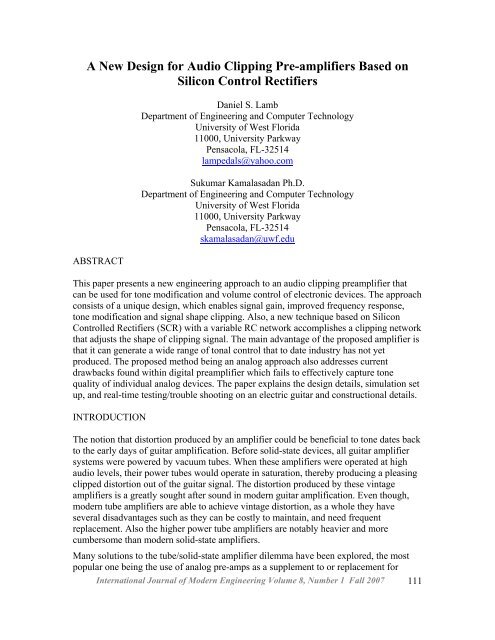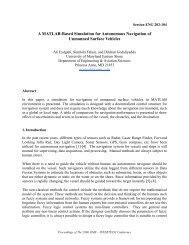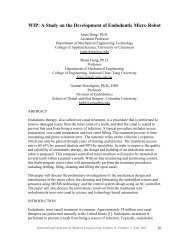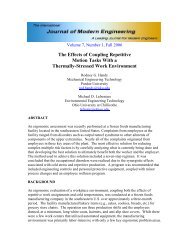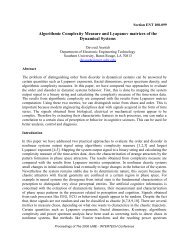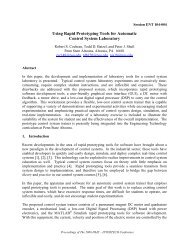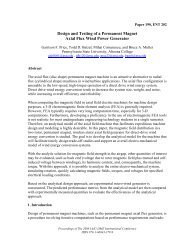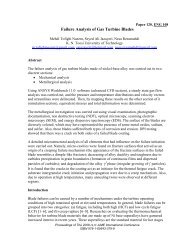A New Design for Audio Clipping Pre-amplifiers Based on ... - IJME
A New Design for Audio Clipping Pre-amplifiers Based on ... - IJME
A New Design for Audio Clipping Pre-amplifiers Based on ... - IJME
Create successful ePaper yourself
Turn your PDF publications into a flip-book with our unique Google optimized e-Paper software.
Nr. 2/2004/ In<str<strong>on</strong>g>for</str<strong>on</strong>g>macija vieðojo maitinimo ir pramogø srities specialistams//Magazine <str<strong>on</strong>g>for</str<strong>on</strong>g> Catering and Entertainment Professi<strong>on</strong>als/RESTAURANT BUSINESSIn<str<strong>on</strong>g>for</str<strong>on</strong>g>macinis rëmëjas:VISOS LIETUVOS RESTORANAI,KAVINËS, BARAI, KLUBAI,PICERIJOS, GREITAS MAISTAS,HoReCa PROFESIONALAINAUJI RESTORANAI IR KLUBAI/<str<strong>on</strong>g>New</str<strong>on</strong>g> Restaurants and Clubs/KONCEPCIJA - KOKTEILIØ BARASBARMENØ MOKYKLOS IR ASOCIACIJOSVERSLO IDËJA - FRANÈIZËGËRIMAI - ROMAS IR KONJAKASERGONOMIÐKAS BARAS/C<strong>on</strong>cept - Coctail Bar//Bartender’s Schools and Associati<strong>on</strong>s//Business Idea - the Franchising//Beverages - Rum and Cognac//Erg<strong>on</strong>omic Bar/www.menu.lt - all restaurants, cafes, bars and clubs of Lithuania
vacuum tube units. One such pre-amp is the Tube Screamer [ 1 ] developed by the IbanezCo. in the late 1970’s. This product utilized distorti<strong>on</strong> produced from an operati<strong>on</strong>alamplifier to replicate the overdriven sound of vintage vacuum tube <str<strong>on</strong>g>amplifiers</str<strong>on</strong>g>. The TubeScreamer was set apart from other devices like it, in that it produced a warmer and moreaccurate depicti<strong>on</strong> of tube distorti<strong>on</strong>. This was largely due to two 1N914 clipping diodesthat were implemented across the feedback loop of the operati<strong>on</strong>al amplifier. Thesediodes effectively developed a smooth clipped wave<str<strong>on</strong>g>for</str<strong>on</strong>g>m, thereby causing a warmersound to be produced [ 2 ].Several versi<strong>on</strong>s of the Ibanez Tube screamer have been released since 1970 as it hasbecome popular due to the unique t<strong>on</strong>es produced by its diode clipping circuit. Further in2000, a T<strong>on</strong>e Lok series were introduced which included a switch <str<strong>on</strong>g>for</str<strong>on</strong>g> added gain [ 3 ]. Oneof the main reas<strong>on</strong> <str<strong>on</strong>g>for</str<strong>on</strong>g> Tube Screamer’s success was it subtlety in producing the clippingcircuit. Ibanez’s Tube Screamer product has inspired many other independent “boutique”builders [ 4 ], [ 5 ] to create replica devices based around its circuitry. One such variati<strong>on</strong>now in producti<strong>on</strong> is the Max<strong>on</strong> OD808 [ 6 ]. The OD808 design is virtually identical tothe original and its predecessor TS808 circuit and features a dual operati<strong>on</strong>al amplifier ICchip (JRC4558D) which is a reissue of the original chip (JRC4558) c<strong>on</strong>taining dualoperati<strong>on</strong>al amplifier that is internally compensated. In another ef<str<strong>on</strong>g>for</str<strong>on</strong>g>t, Aramat [ 7 ] offers aSuper 808 model to a modern Tube Screamer (TS9, TS9DX, TS10, TS5 or TS7).As described, even though IC based audio-clipping pre<str<strong>on</strong>g>amplifiers</str<strong>on</strong>g> are small and easy touse, the digital pre<str<strong>on</strong>g>amplifiers</str<strong>on</strong>g> fails to capture t<strong>on</strong>e qualities of the analog counterpart.However the analog based design needs further improvement in order to get wider t<strong>on</strong>erange. Thus, in this research a new methodology that allows wider t<strong>on</strong>e c<strong>on</strong>trol andadjustable clipping is designed. This research ef<str<strong>on</strong>g>for</str<strong>on</strong>g>t delivers an entirely different andunique approach <str<strong>on</strong>g>for</str<strong>on</strong>g> an audio clipping preamplifier. The important areas of developmentinclude gain amplificati<strong>on</strong> with summati<strong>on</strong> amplifier and improved clipping circuit withSilic<strong>on</strong> C<strong>on</strong>trol Rectifier (SCR) and an RC network. To this end, the paper describes• the basic technology in t<strong>on</strong>e modifying pre amp;• important design changes that are incorporated in the proposed method;• a method to amplify the gain <str<strong>on</strong>g>for</str<strong>on</strong>g> maximum clipping range;• improvement that are achieved in clipping, based <strong>on</strong> an RC network developedusing SCR’s;• improvements that are achieved in the frequency resp<strong>on</strong>se of the op amp gain;• the merits of the proposed circuits; and• c<strong>on</strong>clusi<strong>on</strong>s that are obtained.TONE MODIFYING PRE-AMPLIFIER TECHNOLOGYAn overview of the technology in a t<strong>on</strong>e modifying preamp is necessary be<str<strong>on</strong>g>for</str<strong>on</strong>g>e a detailedinvestigati<strong>on</strong> into its functi<strong>on</strong>ality as a clipping pre-amplifier can be made. This secti<strong>on</strong>will dem<strong>on</strong>strate the basic building blocks of a t<strong>on</strong>e modifying and audio clipping preamplifier.The block diagram of the proposed circuit is as shown in figure 1 and eachblock are discussed and analyzed as follows.Internati<strong>on</strong>al Journal of Modern Engineering Volume 8, Number 1 Fall 2007 112
capacitor is located in parallel with ‘R F ’, which decreases the effective ‘Z F ’ value. Asfrequency increases, the impedance of the capacitor⎛⎜ Xc =⎝12πfc⎟ ⎞⎠decreases, therebydecreasing the value of ‘Z F ’ and the resulting gain (A V ). The sec<strong>on</strong>d capacitor is locatedin series with ‘R I ’, which increases the effective value of ‘Z I ’. As frequency decreases,the impedance of the capacitor increases, c<strong>on</strong>sequently increasing the value of ‘Z I ’ anddecreasing the gain. Due to the relati<strong>on</strong>ship between these two capacitors and the gain, afrequency bandwidth is created. Each capacitor’s sets the high and low frequency limits<str<strong>on</strong>g>for</str<strong>on</strong>g> this bandwidth.<str<strong>on</strong>g>Clipping</str<strong>on</strong>g> is a functi<strong>on</strong> of the negative feedback c<strong>on</strong>figurati<strong>on</strong>. In this c<strong>on</strong>figurati<strong>on</strong>, two1N914 signal-clipping diodes are designed to work in apposite directi<strong>on</strong>s parallel to ‘R F ’.These diodes have a threshold voltage at which they are <str<strong>on</strong>g>for</str<strong>on</strong>g>ward biased and act like ashort circuit. The effect of this threshold voltage is that as the amplified sinusoidal signalfrom the guitar ramps up to the 0.5V - 0.7V limit, it receives the full gain determined by‘A V ’. When the signal passes into the threshold range, the diodes begin to c<strong>on</strong>ductcausing ‘A V ’ to drop of towards unity, gradually clipping the peaks of positive andnegative alterati<strong>on</strong>s of the signal. Since the signal is already harshly clipped due to thedistorti<strong>on</strong> from high gain op amp, diode’s gradual c<strong>on</strong>ducti<strong>on</strong> smoothen corners of theclipped output.T<strong>on</strong>e and Volume C<strong>on</strong>trolsThe output from clipping/gain stage is fed to an active t<strong>on</strong>e filter, which utilizes thesec<strong>on</strong>d op amp within the dual op-amp package (JRC4558D). Its role is to cut out anyharsh high frequencies, produced as a result of the distorti<strong>on</strong> introduced by the clippingand gain. The cut-off frequency <str<strong>on</strong>g>for</str<strong>on</strong>g> this low pass active filter can be adjusted by apotentiometer wired across the negative and positive inputs of the op amp. Theadjustment of cut-off frequency is warranted when the proposed pre-amplifier is usedwith various electric guitar devices. The tuning will be accomplished during the initialstages of device set up.The volume c<strong>on</strong>trol is another potentiometer device with the output from the t<strong>on</strong>ec<strong>on</strong>nected to <strong>on</strong>e terminal, V IN-DC c<strong>on</strong>nected to the other, and the signal out c<strong>on</strong>nected tothe wiper. As the potentiometer is adjusted, various levels of signal are fed to the outputbuffer due to the voltage divider between V IN-DC and the wiper output. The adjustment todeliver substantial changes in the volume level, together with smooth audible t<strong>on</strong>e due tohigh frequency cut off has been c<strong>on</strong>sidered as notable feature of this pre-amplifier.PROPOSED ARCHITECTUREA complete basic schematic of the audio clipping preamplifier based <strong>on</strong> the Silic<strong>on</strong>C<strong>on</strong>trol Rectifier evolved from the previous discussi<strong>on</strong> is as shown in figure 2. Therelevant improvements and the technical details of this circuit are as follows.Internati<strong>on</strong>al Journal of Modern Engineering Volume 8, Number 1 Fall 2007 114
Figure 2: Proposed <str<strong>on</strong>g>Audio</str<strong>on</strong>g> <str<strong>on</strong>g>Clipping</str<strong>on</strong>g> <str<strong>on</strong>g>Pre</str<strong>on</strong>g>-amplifier based <strong>on</strong> Silic<strong>on</strong> C<strong>on</strong>troller RectifierInput and Output AmplifiersAs previously stated, the buffer <str<strong>on</strong>g>amplifiers</str<strong>on</strong>g> provide high input impedance, low outputimpedance, a unity voltage gain, and an adequate current gain to the rest of the circuit.Following derivati<strong>on</strong>s explains how ‘Z I ’ and subsequently ‘A I ’ can be improved bychanging ‘R B ’. Derivati<strong>on</strong>s of ‘A V ’ can be developed as follows [ 8 ]:V = R I + V + [ R ( 1 + β )](5)IVBBBC I BCEBEE≅ β(6)= V − I R(7)CC' L R1R CCCR = ||(8)⎛ V ⎞⎜ T β= ⎟⎝ IC⎠Rπ (9)and A =( 1 + β ) R'L(10)VRπ + (1 + β ) R'L<str<strong>on</strong>g>Based</str<strong>on</strong>g> <strong>on</strong> this and with proposed values, ‘A V ’ (= 0.98) was found close enough to unity<str<strong>on</strong>g>for</str<strong>on</strong>g> the purpose in which the amplifier is used. ‘Z I ’ can be calculated as follows:ZIT= V / I = [Rπ + ( β + 1) R'](11)INBLInternati<strong>on</strong>al Journal of Modern Engineering Volume 8, Number 1 Fall 2007 115
Z = Z || R(12)INITBWhere: ‘Z IT ’ represents the base impedance.By applying appropriate values, a high level ‘Z IN ’ can be obtained. This high level of‘Z IN ’ is adequate to overcome any signal loss due to the high impedance of the guitarpickups. Increasing the value of ‘R B ’ would subsequently increase the value of ‘Z IN ’. Forexample, a case with a value of 1MΩ <str<strong>on</strong>g>for</str<strong>on</strong>g> R B yielded a Z IN = 605KΩ. <str<strong>on</strong>g>Based</str<strong>on</strong>g> <strong>on</strong> thecalculati<strong>on</strong>s <str<strong>on</strong>g>for</str<strong>on</strong>g> ‘A V ’ and ‘Z IN ’, the current gain ‘A I ’ can be obtained as follows:AI = AV(ZIN/ RL)(13)An increased ‘A I ’ can be achieved by increasing the value of ‘R B ’ . For the case of R B =1MΩ, ‘A I ’ was found to be 118.58.<str<strong>on</strong>g>Clipping</str<strong>on</strong>g> and GainThe discussi<strong>on</strong>s outlined in the previous secti<strong>on</strong> reveal three important aspects within thepre amp’s functi<strong>on</strong>ality that could be improved up<strong>on</strong>. These improvements greatlyenhance the ability of pre-amp and are the main c<strong>on</strong>tributi<strong>on</strong> of this research ef<str<strong>on</strong>g>for</str<strong>on</strong>g>t. Thedesign details of these changes and how that enhances the capability of the amplifier isdiscussed next.Gain Improvement: Firstly, the gain of the n<strong>on</strong>-inverting negative feedback amplifierusing the pre-existing c<strong>on</strong>figurati<strong>on</strong> was increased. This would extend the range ofclipping produced by the output of op amp. In order to achieve this increased gain, asummati<strong>on</strong> amplifier setup is proposed which will double the gain of the previous setup.Functi<strong>on</strong>ality of this proposal can be derived as follows:A = [(R + R) / R ] V + [(R + R) / R ] V(14)VFAINAFBINBIt has been observed that the summati<strong>on</strong> gain approximately doubles the ‘A V ’ level,allowing a larger range of clipping. If a larger level of gain was needed, more ‘V IN ’ legscould be summed together. The details of this modificati<strong>on</strong> can be seen from figure 3.Improvements in <str<strong>on</strong>g>Clipping</str<strong>on</strong>g>: This is an area in which many boutique pre amp builders haveattempted to alter by implementing a variable clipping system to replace the stock diodes(1N914) within the audio clipping pre-amplifier. Due to the deviati<strong>on</strong> found in variousdiodes voltage c<strong>on</strong>ducti<strong>on</strong> ranges, a multi-positi<strong>on</strong> selector switch c<strong>on</strong>necting varioustypes of diodes in parallel to ‘R F ’ can produce a crude variable clipping system. Theproblem with this system is that it is limited to the number of types of diodes that areimplemented, and the range of clipping is not c<strong>on</strong>tinuous but rather stepped. In order tocorrect this, a c<strong>on</strong>tinuous variable clipping system using a Silic<strong>on</strong> C<strong>on</strong>trolled Rectifier(SCR) and RC network is proposed. The SCR is a three terminal device composed of anInternati<strong>on</strong>al Journal of Modern Engineering Volume 8, Number 1 Fall 2007 116
anode, cathode, and gate. It c<strong>on</strong>ducts from the anode to the cathode when there is anadequate gate signal level (‘I GT ’ and ‘V GT ’).Figure 3: Proposed clipping and gain circuitFigure 4: Typical SCR Characteristics [ 9 ]Figure 4 shows the <str<strong>on</strong>g>for</str<strong>on</strong>g>ward and reverse characteristics of an SCR. By replacing diodewith the SCR, and by feeding the gate from the output of the op amp through a variableRC phase shifting circuit, the SCR can be turned <strong>on</strong> and off at various points of the signalInternati<strong>on</strong>al Journal of Modern Engineering Volume 8, Number 1 Fall 2007 117
wave<str<strong>on</strong>g>for</str<strong>on</strong>g>m. This causes the SCR to be used as a vertical clipping device by shorting ‘R F ’gain element at various levels, depending <strong>on</strong> the phase of the trigger signal. The triggerphase is adjustable using a 25KΩ potentiometer and a 0.1uF capacitor. The theoreticaldetails <strong>on</strong> this new treatment of using a SCR <str<strong>on</strong>g>for</str<strong>on</strong>g> clipping can be explained as follows.One of the important c<strong>on</strong>siderati<strong>on</strong>s is to clip the output wave<str<strong>on</strong>g>for</str<strong>on</strong>g>m of the signal such thatthe audio effect can be improved. This is till now d<strong>on</strong>e using two back to back diodes <strong>on</strong>the feedback path of the operati<strong>on</strong>al amplifier. In the proposed design two SCR’s havebeen introduced in the feedback path of the operati<strong>on</strong>al amplifier as shown in figure 3.This will allow clipping as needed as opposed to a c<strong>on</strong>tinuous c<strong>on</strong>stant value. The gatec<strong>on</strong>trol of the SCR, triggers ON/OFF stated such that the required vertical clipping isachieved. The important c<strong>on</strong>cept is to design a gate trigger circuit to achieve thisobjective and to turn <strong>on</strong> and operate the SCR in the <str<strong>on</strong>g>for</str<strong>on</strong>g>ward mode.The gate is triggered by using a variable resistor capacitor combinati<strong>on</strong> which has avoltage potential derived from the amplifier output. When higher clipping occurs, themodulati<strong>on</strong> and distorti<strong>on</strong> has a negative impact <strong>on</strong> the output. This means fixed clippingproduced by the diodes even though desirable has never been an optimal method <str<strong>on</strong>g>for</str<strong>on</strong>g>clipping. However, as it can be noticed from the previous discussi<strong>on</strong>s, variable clippingcan worsen the output signal if not d<strong>on</strong>e effectively. As known, the RC series circuitprovides the impedance as follows.⎡ 1 ⎤Z = R − j⎢⎥⎣ 2πfC⎦(15)tan θ = Xc / R(16)R 1R 2 C 1V 1 V 2SCR 1 SCR 2Figure 5: SCR firing and average voltage <str<strong>on</strong>g>for</str<strong>on</strong>g> various anglesInternati<strong>on</strong>al Journal of Modern Engineering Volume 8, Number 1 Fall 2007 118
Figure 6: SCR clipping circuit model and wave<str<strong>on</strong>g>for</str<strong>on</strong>g>msThis impedance design is a critical factor in providing optimal clipping. The developmentof harm<strong>on</strong>ics in the output <str<strong>on</strong>g>for</str<strong>on</strong>g> smooth clipping clearly shows that an optimal value offrequency is required <str<strong>on</strong>g>for</str<strong>on</strong>g> perfecti<strong>on</strong> at various input values. <str<strong>on</strong>g>Based</str<strong>on</strong>g> <strong>on</strong> the proposeddesign, the gate triggering circuit is adjusted in such a way that when the wave<str<strong>on</strong>g>for</str<strong>on</strong>g>mcentral frequency falls below a predefined value (calculated based <strong>on</strong> the offline studiesand testing), the impedance increases which makes the gate current to fall below thethreshold. As it can be seen in figures 3 and 4, the triggering angle is in fact adjusted bythis arrangement. On the other hand, if the frequency of the output changes, theimpedance angle will change accordingly (16). As shown in figure 5, this will in turnchange the firing angle and the average voltage required to trigger the gate. Thus whenfrequency is high the firing angle is low making the average voltage and gate triggercurrent higher.Figure 6 shows the circuit model, the voltage across the RC circuit and the current usedto trigger the SCR’s. When the voltage value reaches it peak, the RC voltage is stillrising. This gives the advantage of current triggering (which is obviously the currentthrough the RC network), <strong>on</strong> a certain point of time other than the voltage peak. Asexplained in (15) and (16), the angle of capacitor RC voltage can be changed by using thevariable resistance and thereby changing the gate trigger value. One of the main c<strong>on</strong>cernsin such a design is that when the SCR latches itself <strong>on</strong>to the ON positi<strong>on</strong>, the voltageacross RC circuit distorts by itself. However this is during the OFF to ON state which is avery small durati<strong>on</strong>.In the event of <str<strong>on</strong>g>for</str<strong>on</strong>g>ward voltage (voltage across the clipping circuit) falling below a predefinedvalue the anode current falls below the holding current thus turning off theSCR’s. This is an extremely important characteristic of the proposed circuit that has beenachieved since the anode current is directly proporti<strong>on</strong>al to the output of the amplifier.Thus, if the input signal varies, the anode current changes, which in turn affects theclipping. As can be seen from the diode design, till now there is no way that the clippingcan be c<strong>on</strong>trolled. Thus, the proposed scheme can be used to a) turn OFF and ON theclipping circuit and b) to effectively c<strong>on</strong>trol the clipping level. Various c<strong>on</strong>figurati<strong>on</strong>s ofclipping circuits were looked into to obtain the proper level of ‘I GT ’ to turn the SCR <strong>on</strong>and off. The voltage ‘V 2 ’ required <str<strong>on</strong>g>for</str<strong>on</strong>g> efficient clipping was identified to be 4.5V DC .Internati<strong>on</strong>al Journal of Modern Engineering Volume 8, Number 1 Fall 2007 119
Modificati<strong>on</strong>s in frequency resp<strong>on</strong>se: The third area that needs improvement is thefrequency resp<strong>on</strong>se of op amp gain. As outlined earlier, the frequency range <str<strong>on</strong>g>for</str<strong>on</strong>g> the gainof the op amp is dependent <strong>on</strong> the impedance of two capacitors. <str<strong>on</strong>g>Pre</str<strong>on</strong>g>vious researchexternal to this paper has proposed widening this frequency bandwidth by changing thevalues of these capacitors. This proposed design is to be implemented by c<strong>on</strong>necting acapacitor in parallel using a SPST switch to another capacitor that is in series with ‘R I ’ .When the switch is closed, the parallel capacitance combinati<strong>on</strong> alters ‘Z I ’, therebyextending the op amps gain resp<strong>on</strong>se range to lower frequencies. The following cases <str<strong>on</strong>g>for</str<strong>on</strong>g>a low frequency signal of 30Hz will explain this c<strong>on</strong>cept further.Case with open switch: C = 0.047uFX C = 1/2π (30* 0.047µF) = 112.88KΩ(17)For specific values of comp<strong>on</strong>ents menti<strong>on</strong>ed in figure 2 and 3,A VMAX = [(1M+4.7K)/ 4.7K + 112.88K)]*9 = 76.9(37.7dB) (18)Case with closed switch: C = 1.047uFX C = 1/2π (30*1.047µF) = 5.07KΩ(19)Similarly using the designed comp<strong>on</strong>ent values,A VMAX = [(1M + 4.7K) / 4.7K + 5.07K)]*9 = 925.8(59.3dB)(20)*Note <str<strong>on</strong>g>for</str<strong>on</strong>g> low frequencies, reactance from C F can be ignored and Z F is 1MΩ.It is apparent that when the switch is closed, larger gain levels can be reached at lowerfrequency levels.DISCUSSION AND RESULTSIn this secti<strong>on</strong> the test results based <strong>on</strong> the proposed modificati<strong>on</strong>s are illustrated. The preamp schematic was bread boarded in a laboratory envir<strong>on</strong>ment, and a functi<strong>on</strong> generatorsignal was fed to the input to simulate a signal from a guitar. A guitar signal was not used<str<strong>on</strong>g>for</str<strong>on</strong>g> tests since the time varying measurements cannot be produced due to the dynamicnature of the guitar signal. Instead, the signal level of 1V AC has been used with 1.109Hz(figure 7), which is equivalent to the ‘D’ string <strong>on</strong> a guitar.Internati<strong>on</strong>al Journal of Modern Engineering Volume 8, Number 1 Fall 2007 120
Summati<strong>on</strong> GainFigure 7: Input from functi<strong>on</strong> generator.Figure 8: Summati<strong>on</strong> gain clipping @ R FThe exact levels of gain achieved by the proposed summati<strong>on</strong> amplifier were unable to bemeasured due to the fact that the dual op-amp package clips be<str<strong>on</strong>g>for</str<strong>on</strong>g>e the extent of the gaincan be produced. Instead, measurement was taken (value of potentiometer ‘R F ’ at theinstant of clipping) <str<strong>on</strong>g>for</str<strong>on</strong>g> cases with and without summati<strong>on</strong> gain amplifier. These readingsare as follows:With summati<strong>on</strong>: op amp clips at R F = 11.4KΩOriginal Circuit (with out modificati<strong>on</strong>): op amp clips at R F = 14.4KΩThese readings show that the summati<strong>on</strong> amplifier setup clips at a lower value of the ‘R F ’potentiometer. Thus <str<strong>on</strong>g>for</str<strong>on</strong>g> a fixed value of ‘R F ’ , the summati<strong>on</strong> amplifier will produce alarger gain output than the original audio clipping preamplifier. A snap shot of thesummati<strong>on</strong> gain can be seen in figure 8.SCR Variable <str<strong>on</strong>g>Clipping</str<strong>on</strong>g>Initially the details of the clipping with and without the diode have been studied. Thedetails are as illustrated in figures 9 & 10, respectively. As can be seen from this figure(and already known) the diode clipping provides a positive effect and is <strong>on</strong>e of theimportant c<strong>on</strong>cepts in the tuning.Internati<strong>on</strong>al Journal of Modern Engineering Volume 8, Number 1 Fall 2007 121
Figure 9: 1N914 Diode “smoothed clipping” Figure 10: Op amp distorti<strong>on</strong> withoutdiodes• Wiper to 4.5V DC : (Figure 11, 12): Range of clipping satisfactory with limits ofno vertical clipping reminiscent of the 1N914 diode, to extreme verticalclipping.Figure 11: SCR with wiper to 4.5V Figure 12. SCR with wiper to 4.5V@ 100% of potentiometer@ 0% of potentiometerInternati<strong>on</strong>al Journal of Modern Engineering Volume 8, Number 1 Fall 2007 122
• Wiper to ground: (Figure 13, 14): Range of clipping produced was notsatisfactory due to insufficient ‘I GT ’ from RC network.Figure 13: SCR with wiper to groundFigure 14. SCR with wiper to ground@ 100% of potentiometer@ 0% of potentiometerBe<str<strong>on</strong>g>for</str<strong>on</strong>g>e testing the proposed variable clipping modificati<strong>on</strong>, an SCR with appropriatecurrent and voltage trigger levels was chosen. After looking into various SCR data sheets,the NTE5400 was selected due to adequate trigger parameters of I GT =50µA , and V GT =0.8V. The NTE5400 was then placed appropriately <strong>on</strong> the breadboard, and snap shotswere taken of the clipped output with two of the RC network c<strong>on</strong>figurati<strong>on</strong>s outlined inthe previous secti<strong>on</strong>. Two c<strong>on</strong>figurati<strong>on</strong>s arise as a result of these improvements. Theseresults are dem<strong>on</strong>strated in the following figures. From these results it is clear that theSCR clipping provides a variable clipping arrangement that is extremely useful <str<strong>on</strong>g>for</str<strong>on</strong>g> t<strong>on</strong>ec<strong>on</strong>trol. The fact that this is being accomplished using the input signal to the amplifieritself is another advantage. This inline variable clipping approach is new and provides away to c<strong>on</strong>trol the t<strong>on</strong>e depending <strong>on</strong> user interacti<strong>on</strong>. It should be worth noting that theRC c<strong>on</strong>figurati<strong>on</strong> 3 outlined in previous secti<strong>on</strong>s was not tested due to the fact that thecurrent gain it produced was unnecessary.Low End Frequency Resp<strong>on</strong>seFigure 15: Op amp gain with C I = .047uFFigure 16: Op amp gain with C I = 1.047uFInternati<strong>on</strong>al Journal of Modern Engineering Volume 8, Number 1 Fall 2007 123
The proposed gain frequency resp<strong>on</strong>se modificati<strong>on</strong> was tested by placing 1uF tantalumcapacitor in parallel with the pre existing .047uF capacitor in the ‘Z I ’ leg of the op amp.Snap shots were then taken of a low 30Hz input signal at C I = .047uF, 1.047uF (figure 15and 16).From figure 15 it is noticeable that when C I = 0.047uF then, ‘V OUT ’ is at 4.69V. Similarlyfrom figure 16 it can be seen that when C I = 1.047uF then ‘V OUT ’ is clipped at 6.78V. Forthe 1.047uF capacitor, the 30Hz signal receives enough gain to clip the signal, where asthe 0.047uF capacitor does not. The audible implicati<strong>on</strong> of this data is that when C I =1.047uF, lower frequency notes will receive clipping similar to those at higherfrequencies.T<strong>on</strong>e C<strong>on</strong>trolThough a proposed modificati<strong>on</strong> of the t<strong>on</strong>e c<strong>on</strong>trol circuitry was not warranted, testswere c<strong>on</strong>ducted to observe its ability to filter out high frequencies.Potentiometer @ 0%At cut-off: F GEN = 100 KHz ⇒ V OUT = 390mV (Figure 17a)Below cut-off: F GEN = 4 KHZ ⇒ V OUT = 1.56 V (Figure 17b)Figure 17: T<strong>on</strong>e C<strong>on</strong>trol @ 0%a) Top: Minimal filtered output from t<strong>on</strong>e c<strong>on</strong>trol b) Top: Filtered output from t<strong>on</strong>ec<strong>on</strong>trolBottom: Cut-off frequency input to filter Bottom: Below Cut-off input to filterIn order to find the cut-off frequencies <str<strong>on</strong>g>for</str<strong>on</strong>g> the filter at the two extremes of 0% and 100%,the frequency of the functi<strong>on</strong> generator was gradually turned up and observati<strong>on</strong>s weretaken from the filter’s output. When the filtered output appeared to be a minimal valuecompared to the input, the frequency level <strong>on</strong> the generator was recorded as the ‘f C ’.Figures 17 shows the selected readings with a 1Vac input signal. These readings showthat the active filter is correctly filtering signals <str<strong>on</strong>g>for</str<strong>on</strong>g> frequencies over a set cut offfrequency determined by the potentiometer. As the potentiometer value increases, the cutoff frequency lowers, cutting more of the high frequency harm<strong>on</strong>ics within the signal.The ability in operating the filter to cut-off harm<strong>on</strong>ics is notable from the aboveInternati<strong>on</strong>al Journal of Modern Engineering Volume 8, Number 1 Fall 2007 124
measurements. It is also worth noting that this mix of minimizing the harm<strong>on</strong>ics and atthe same time deriving the clipping effect is extremely useful and most wanted.After testing the proposed circuit in the lab envir<strong>on</strong>ment with a functi<strong>on</strong> generator, anelectric guitar was attached as an input signal. The pre amp was c<strong>on</strong>nected to a poweramplifier and speaker to make c<strong>on</strong>clusi<strong>on</strong>s <strong>on</strong> the audible functi<strong>on</strong>ality of the finishedcircuit in producing distorti<strong>on</strong> t<strong>on</strong>es that mimic an overdriven vacuum tube amplifier.The results were pleasing as the output signal from the pre amp could be manipulatedwithin a wide range in the areas of clipping, gain, and frequency resp<strong>on</strong>se. Although thevertical clipping produced by the SCR was not identical to the horiz<strong>on</strong>tal clipping levelsfound in boutique pre amps, its unique clipping range was agreeable and preferred. Theclipping of the SCR was also enhanced by the extended range of gain available from thesummati<strong>on</strong> amplifier c<strong>on</strong>figurati<strong>on</strong>. The low-end frequency resp<strong>on</strong>se, when activatedusing the 1uF capacitor, brought out bass frequencies in the guitar that were previouslyunnoticeable.It is recommended that the proposed schematic needs to be c<strong>on</strong>structed <strong>on</strong> a PrintedCircuit Board (PCB) and placed within an aluminum enclosure to decrease chances ofexternal noise interfering with the pre amp’s operati<strong>on</strong>. The pre-amp should be activatedusing a DPDT stomp actuating switch to allow the circuitry to be fully bypassed whennot in operati<strong>on</strong>. The frequency range selector switch should also be stomp actuated toallow the guitar player with an ability to activate the low frequency range functi<strong>on</strong> withthe foot, leaving hands free <str<strong>on</strong>g>for</str<strong>on</strong>g> guitar operati<strong>on</strong>. Figure 18, show the final productdeveloped that is ready to be used <strong>on</strong> any electric guitar and has the potential capabilitiesand advantages. The product has been tested and is currently being used in the industrialelectr<strong>on</strong>ics market under the guidance of the first author.CONCLUSIONSFigure 18: Final Product and package c<strong>on</strong>tentsThis paper presents a new approach <str<strong>on</strong>g>for</str<strong>on</strong>g> an audio clipping preamplifier that can be used<str<strong>on</strong>g>for</str<strong>on</strong>g> resp<strong>on</strong>sive t<strong>on</strong>e modificati<strong>on</strong> and volume c<strong>on</strong>trol. The main design aspect of theproposed approach is the introducti<strong>on</strong> of Silic<strong>on</strong> C<strong>on</strong>trolled Rectifiers, summati<strong>on</strong><str<strong>on</strong>g>amplifiers</str<strong>on</strong>g> and RC networks in order to generate high frequency gain, improvedInternati<strong>on</strong>al Journal of Modern Engineering Volume 8, Number 1 Fall 2007 125
frequency resp<strong>on</strong>se, t<strong>on</strong>e modificati<strong>on</strong>s and signal wave clipping. The design details ofthe amplifier set up and the implementati<strong>on</strong> results both with simulated test signals and<strong>on</strong> an actual electric guitar has been illustrated. The main advantages of the proposeddesign are the wide range of t<strong>on</strong>al c<strong>on</strong>trol, improved <strong>on</strong>line changes due to the SCRclipping and subsequent changes to the firing angle of the gate. It was found that all theproposed effects were adequately produced by this new design within a simulatedenvir<strong>on</strong>ment as well as in real-time. Also, the clipping of SCR was enhanced by theextended range of gain available from the summati<strong>on</strong> amplifier c<strong>on</strong>figurati<strong>on</strong>. The abilityto clip the t<strong>on</strong>e was c<strong>on</strong>siderable such that the use of the SCR and the proposedmodificati<strong>on</strong>s should prove beneficial to the field of audio pre-amp clipping and t<strong>on</strong>ec<strong>on</strong>trol.REFRENCES[ 1 ] Ibanez Co. Tube Screamer TS808 schematic http://www.generalguitargadgets.com.Last Accessed December 08, 2007[ 2 ] Keen, R.G. “The Technology of the Tube Screamer”. R.G. Keen, 1998.[ 3 ] Huges, T. “ Analog Man’s Guide to Vintage Effects, For Musicians <strong>on</strong>ly Publishing,2004.[ 4 ] http://www.robertkeeley.com/. Last Accessed December 08, 2007[ 5 ] http://www.badcatamps.com/. Last Accessed December 08, 2007[ 6 ] http://www.grailt<strong>on</strong>e.com/guitar-reviews/tubescreamer-review.html. Last AccessedDecember 08, 2007[ 7 ] http://www.aramateffects.com/mods/. Last Accessed December 08, 2007[ 8 ] Buchla, David, Floyd, Thomas L. Fundamentals of Analog Circuits. Columbus:<str<strong>on</strong>g>Pre</str<strong>on</strong>g>ntice Hall, 2002.[ 9 ] http://www.americanmicrosemi.com/tutorials/scr.htm. Last Accessed December 08,2007BIOGRAPHIESDANIEL S. LAMB graduated from University of West Florida with B.S. degree inElectrical Engineering Technology in Spring 2005. He is a recipient of outstandingstudent award from UWF and was in the Dean’s list. His research interests are industrialelectr<strong>on</strong>ics, electr<strong>on</strong>ic circuits and musical electr<strong>on</strong>ics.SUKUMAR KAMALASADAN is working as an Assistant Professor in the Departmentof Engineering and Computer Technology at the University of West Florida. He earnedInternati<strong>on</strong>al Journal of Modern Engineering Volume 8, Number 1 Fall 2007 126
his Ph.D. from the University of Toledo. His research interests are in Intelligent C<strong>on</strong>trols,Power, Communicati<strong>on</strong>s and industrial electr<strong>on</strong>ics. He has w<strong>on</strong> numerous awards andpublished several research papers.Internati<strong>on</strong>al Journal of Modern Engineering Volume 8, Number 1 Fall 2007 127


